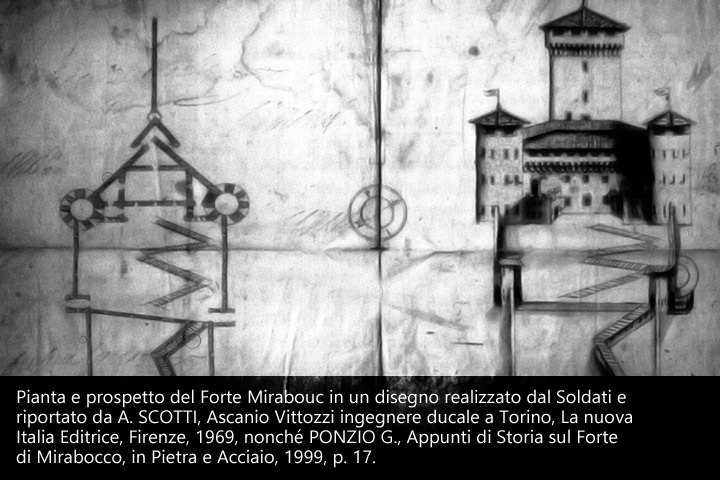Monographic sheet: the Fort of Mirabouc
Sixteenth century fortification near Villanova, Bobbio Pellice
In Val Pellice, before the construction of the Alpine Wall "bunkers" at Col Content and at Col Barant, the closest fortified structure to France border was the Fort of Mirabouc, of which unfortunately today there are very few remains, which almost always pass unnoticed by hikers.

After passing Villanova, going towards Conca del Prà, you reach Mirabouc locality, at the exact point where the carriageway crosses the path that goes directly to the town of Villanova. With watchful eye, it is possible to see, on the uphill rock, the faded red writing indicating the existence of the Fort Mirabouc and the elevation (1,410 meters above sea level), of which, looking up, stand the lowest bastion remains. The name might derive from the dialectal "meira", which indicates the mountain hut made of typical stone of the Western Alps, where to migrate in summer following the flocks - and "bouc", goat.
Fort Mirabouc was probably built around the 1565, by order of the Duke Emanuele Filiberto of Savoy and Sebastiano Grazioli Castrocaro, governor of the Val Pellice on behalf of the Duke. The scope of the Fort was not really to prevent a French invasion, but to support the Forte Santa Maria in preventing and avoiding the contacts between the Waldensian of the Pellice, Angrogna, and Germanasca valleys with coreligionists of Queyras.
Therefore, the construction of the fort has a number of different reasons. After the peace treaty between France and Spain in 1559 in Cateau-Cambrésis, the Duke of Savoy regained possession of most of the territories that belonged to his ancestors and had an urgent need to "build a state". To do this, the primary requirement consisted in erecting a fortification system, which would permit the defense from the outside and the control.

In 1794, after many vicissitudes between the sixteenth and the eighteenth century, the fort was demolished by French revolutionaries during a military action across the border.
Bibliography
- JALLÀ G., La riforma in Piemonte negli anni 1595-1596, in Bulletin de la Société d'Histoire Vaudoise n. 46, p. 31
- MORELLO C., Avvertimenti sopra le fortezze di SAR del Capitano Carlo Morello primo Ingegner et logotenente Generale di Sua artiglieria MDCLVI, BR, Manoscritti Mil 178, dis. 39
- PONS T., Vicende del forte Mirabuc, Tipografia Subalpina, Torre Pellice
- PONZIO G., Appunti di Storia sul Forte di Mirabocco, in Pietra e Acciaio, 1999
- RIVOIRE P., Storia dei Signori di Luserna, p. II, in Bulletin de la Société d'Histoire Vaudoise n. 13, p. 85
- SCOTTI A., Ascanio Vittozzi ingegnere ducale a Torino, La nuova Italia Editrice, Firenze, 1969

